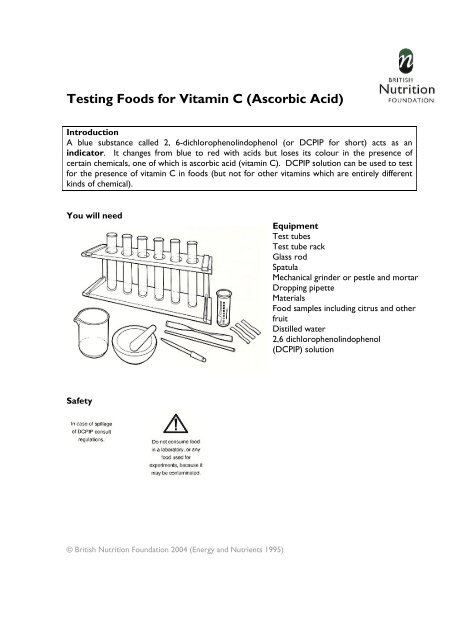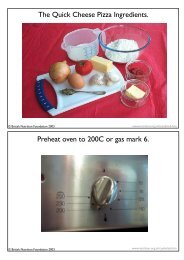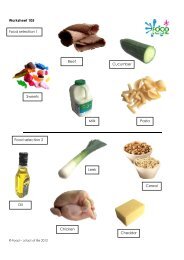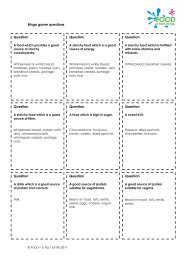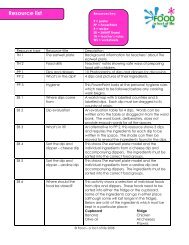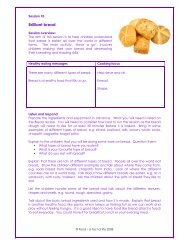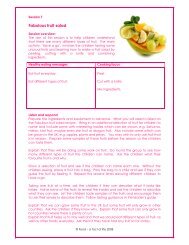Testing Foods for Vitamin C (Ascorbic Acid) - Food a fact of life
Testing Foods for Vitamin C (Ascorbic Acid) - Food a fact of life
Testing Foods for Vitamin C (Ascorbic Acid) - Food a fact of life
- No tags were found...
You also want an ePaper? Increase the reach of your titles
YUMPU automatically turns print PDFs into web optimized ePapers that Google loves.
<strong>Testing</strong> <strong><strong>Food</strong>s</strong> <strong>for</strong> <strong>Vitamin</strong> C (<strong>Ascorbic</strong> <strong>Acid</strong>)IntroductionA blue substance called 2, 6-dichlorophenolindophenol (or DCPIP <strong>for</strong> short) acts as anindicator. It changes from blue to red with acids but loses its colour in the presence <strong>of</strong>certain chemicals, one <strong>of</strong> which is ascorbic acid (vitamin C). DCPIP solution can be used to test<strong>for</strong> the presence <strong>of</strong> vitamin C in foods (but not <strong>for</strong> other vitamins which are entirely differentkinds <strong>of</strong> chemical).You will needEquipmentTest tubesTest tube rackGlass rodSpatulaMechanical grinder or pestle and mortarDropping pipetteMaterials<strong>Food</strong> samples including citrus and otherfruitDistilled water2,6 dichlorophenolindophenol(DCPIP) solutionSafety© British Nutrition Foundation 2004 (Energy and Nutrients 1995)
Method1. If the food to be tested is liquid, go to 2. if the food to betested is solid, make an extract. Grind, crush or chop asmall amount and put it into a test tube to a depth <strong>of</strong> about2cm. Add a similar amount <strong>of</strong> distilled water and stir withglass rod. Allow to stand <strong>for</strong> a few minutes.2. Draw up some <strong>of</strong> the clear liquid into a pipette and then addit, one drop at a time, to a test tube containing a light bluesolution <strong>of</strong> DCPIP. If the extract is acid the colour willchange from blue to red. Continue to add more and see ifthe colour disappears altogether.3. Decolourisation <strong>of</strong> DCPIP shows that a vitamin C isprobably present. Other chemicals can do this in food anddrink, but vitamin C is the main one.Extension workThe method can be adapted to make a rough comparison between theamounts <strong>of</strong> vitamin C in two (or more) different foods.1. Begin with exactly the same quantities <strong>of</strong> two food samples. If it isnecessary to add water, then add exactly the same amount to eachextract.2. Draw the liquid from the first extract into a burette and run it, drop bydrop, into a measured amount <strong>of</strong> standard * DCPIP solution until thecolour just disappears. Note the amount <strong>of</strong> DCPIP used.3. Do the same with the second extract using the same amount <strong>of</strong> DCPIPsolution. Comparison <strong>of</strong> the amounts <strong>of</strong> extract used will give someindication <strong>of</strong> the relative quantities <strong>of</strong> vitamin C in the food samples. Ifless extract is used, the sample contains more vitamin C.* Standard solution: one solution is prepared in advance and identicalportions are used <strong>for</strong> each test.© British Nutrition Foundation 2004 (Energy and Nutrients 1995)


